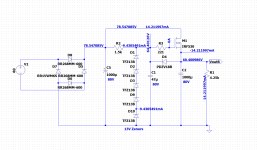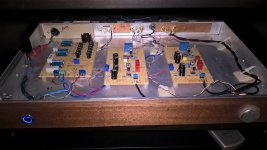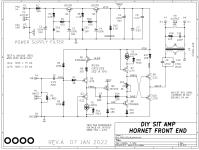Ok,
First of al I don't think the name of "cap multiplier" is a good choice as it's actually an RC filter buffered with a darlington transistor.
Now recently I needed a power supply for some preamps (+24v) and wasn't really sure if the used capacitance was good enough.
So i added the simple cap multiplier circuit.
Most of the time I just use an lm317 and it's adequate. Especially for opamps.
78xx is to noisy.
The lm317 is ok but it's not the best for ripple suppression.
So when testing the ripply at the output of the preamps as around -82dbu using only the lm317 psu
When using the cap multiplier this sunk to -100dbu.
It doesn't matter that much for one preamp but when summing 16 or more of these outputs together it makes a difference.
the preamps where discrete class A so not much psrr.
So why isn't the cap multiplier used more for preamps? it's not expensive to implement. Could be a nice extra for working with tubes.
I've seen it once in some older siemens transistor preamp modules.
any comments are welcome
First of al I don't think the name of "cap multiplier" is a good choice as it's actually an RC filter buffered with a darlington transistor.
Now recently I needed a power supply for some preamps (+24v) and wasn't really sure if the used capacitance was good enough.
So i added the simple cap multiplier circuit.
Most of the time I just use an lm317 and it's adequate. Especially for opamps.
78xx is to noisy.
The lm317 is ok but it's not the best for ripple suppression.
So when testing the ripply at the output of the preamps as around -82dbu using only the lm317 psu
When using the cap multiplier this sunk to -100dbu.
It doesn't matter that much for one preamp but when summing 16 or more of these outputs together it makes a difference.
the preamps where discrete class A so not much psrr.
So why isn't the cap multiplier used more for preamps? it's not expensive to implement. Could be a nice extra for working with tubes.
I've seen it once in some older siemens transistor preamp modules.
any comments are welcome
I have not used a cap multiplier for a preamp but I have used a shunt regulator that is very similar in operation. In fact it is a cap multiplier with a zener shunt added. It works quite well in my preamps, and I am sure many others have used this type of regulator in preamps and even amps. The output device can be chosen for low or high current and power dissipation.
Attachments
John Curl did use this circuit, in the Blowtorch and in others.
Instead you could call it a capacitor shrinker, since the transistor allows a much smaller capacitor value
than otherwise, for the same noise reduction. But the proper circuit only has a very small output capacitor.
Instead you could call it a capacitor shrinker, since the transistor allows a much smaller capacitor value
than otherwise, for the same noise reduction. But the proper circuit only has a very small output capacitor.
Last edited:
I use CapMx circuits for all my builds, no matter if its linear or SMPS, for solid state and tube projects.
Below you can see the one I use for a Pearl I RIAA pre with a 48VDC SMPS as its input. Works like magic with no noise or hum whatsoever, even when you listen with headphones.
What's not shown is the RCRC filter after the SMPS, preceding this circuit to drop the input to 39VDC.
All fits on a 10cm x 10cm veroboard.
Below you can see the one I use for a Pearl I RIAA pre with a 48VDC SMPS as its input. Works like magic with no noise or hum whatsoever, even when you listen with headphones.
What's not shown is the RCRC filter after the SMPS, preceding this circuit to drop the input to 39VDC.
All fits on a 10cm x 10cm veroboard.
Attachments
Last edited:
Hi i am interested a lot in your experience I have some questionsOk,
First of al I don't think the name of "cap multiplier" is a good choice as it's actually an RC filter buffered with a darlington transistor.
Now recently I needed a power supply for some preamps (+24v) and wasn't really sure if the used capacitance was good enough.
So i added the simple cap multiplier circuit.
Most of the time I just use an lm317 and it's adequate. Especially for opamps.
78xx is to noisy.
The lm317 is ok but it's not the best for ripple suppression.
So when testing the ripply at the output of the preamps as around -82dbu using only the lm317 psu
When using the cap multiplier this sunk to -100dbu.
It doesn't matter that much for one preamp but when summing 16 or more of these outputs together it makes a difference.
the preamps where discrete class A so not much psrr.
So why isn't the cap multiplier used more for preamps? it's not expensive to implement. Could be a nice extra for working with tubes.
I've seen it once in some older siemens transistor preamp modules.
any comments are welcome
1) did you place the cap multipliers before the LM317 ? would you mind sharing the circuit ?
2) did you tried the 24V fixed regulators ?
3) have you simulated the power supply circuit or carried out any measurement maybe ?
4) have you experienced any difference in the sound ?
I have a very similar issue i.e. needing a +/-24VDC power solution.
I have only used fixed regulators by now. Their performance depends clearly on the PSRR of the powered circuit
But i would love the idea of a very low noise power supply
Thanks a lot and kind regards
gino
- Home
- Amplifiers
- Power Supplies
- Cap multiplier for very quite preamp power supply?


